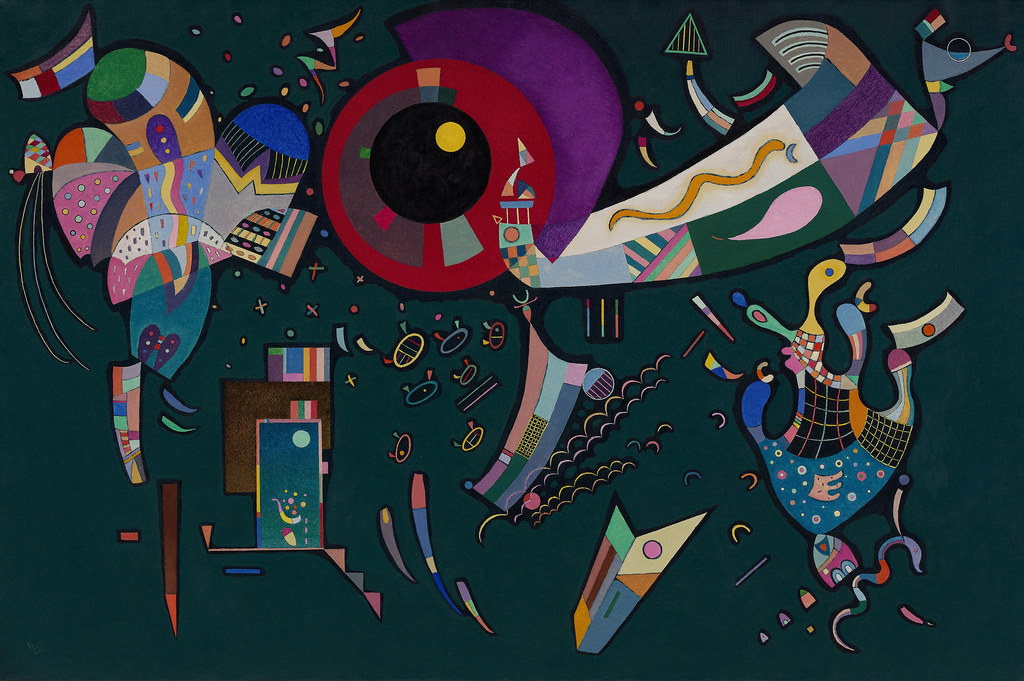Wassily Wassilyevich Kandinsky was a Russian painter and art theorist. Kandinsky is generally credited as the pioneer of abstract art.

Image source: https://search.creativecommons.org/photos/ccd769a8-1ddb-4d96-9b8b-43617ed87e77 by Tulip Hysteria / Go to albums
Pioneer of modern abstract art Wassily Kandinsky exploited the evocative interrelation of color and form and succeeded to create an aesthetic experience that involves the sight, sound, and emotions of the audience. According to him, total abstraction offered the possibility of profound, and transcendental expression.
Life and education

Image source: https://search.creativecommons.org/photos/83241c0a-aef7-4798-8b61-23044bea85eb , Cea.
Wassily Kandinsky was born on December 16th, 1866 in Moscow, into a wealthy family and in a good cultural environment. In the works of Kandinsky from his childhood, it is possible to find quite specific color combinations, which he explained by the fact that “each color lives by its mysterious life”. In the year 1886, he went to Moscow and entered the Faculty of Law of the Moscow University, then in 1896 in the famous Derpt University of Tartu, where at that time the Russification process was taking place, a thirty-year-old Kandinsky was appointed Professor in the Department of Law, but decides to abandon a successful career to devote himself completely to painting. Two events influenced this decision: his visit to an exhibition of the French impressionists in Moscow in 1895 and an emotional shock he felt from K. Monet’s, “Haystacks”, and an impression of Richard Wagner’s “Lohengrin” at the Bolshoi Theatre.

Image source: https://en.wikipedia.org/wiki/File:Kandinsky_-_Jaune_Rouge_Bleu.jpg
Early art and color studies
In 1896 he left for Munich, at that time considered one of the centers of European art, and entered the prestigious private school of painting of Anton Azbe (Yugoslavian artist), where he received the first skills in image composition, in working with the line and form, however, the school soon ceased to meet his needs.

Image source: https://search.creativecommons.org/photos/ccd769a8-1ddb-4d96-9b8b-43617ed87e77 by Tulip Hysteria / Go to albums
At the time Kandinsky met a young artist, Gabriela Munter, and in 1903 he divorced his wife, Anna Chimyakina. In the following five years he travels with Gabriela throughout Europe, dedicating himself to painting and participating in exhibitions, and once back in Bavaria, they settled in a small town of Murnau at the foot of the Alps. From here began a phase of intense and fruitful research. The works of those years were mainly landscapes, based on chromatic discord. The play of color spots and lines was gradually supplanting the images of reality.
The Blue rider

Image source: https://en.wikipedia.org/wiki/The_Blue_Rider_(painting)
Kandinsky thanks to his active creativity and organizational skills always attracted something intellectual, restless, ambitious, which was in the art world of that time. Thus, in 1901 he founded Phalanx, an art group, in Munich and started a school, in which he self-taught. For four years Kandinsky had twelve exhibitions of Phalanx member painters. In 1909 together with Jawlensky, Kanoldt, Kulbin, Munter, and others, he founded The New Group of Artists, Munich (MKUM) and became its President. In 1911 Kandinsky together with his friend, Frantsem Mark, an artist, founded a group called Blue Rider (Blaue Reiter).
The teaching at Bauhaus

Image source:https://search.creativecommons.org/photos/0a22c2ea-3f27-4acb-a651-417af6627033 by rverc

Image source: https://en.wikipedia.org/wiki/File:Vassily_Kandinsky,_1923_-_Circles_in_a_Circle.jpg
After the First World War, back in Germany, Kandinsky accepts the invitation of Walter Gropius, the founder of the well-known Bauhaus (the high school of construction and artistic design) and he and Nina moved to Weimar where Kandinsky directs a fresco workshop. He also develops a profound analytical study of the separate elements of a painting, which resulted in “Point and Line on the Plane” in 1926. He worked extensively and experimented with color, applying his analytical foundation and conclusions in his teaching. Kandinsky’s works changes once again: the individual geometric elements come more and more into the foreground, his palette is satisfied with cold chromatic harmonies which, at times, are perceived as dissonance, the circle is used differently, as a sensual symbol of perfect shape.

Image source: https://search.creativecommons.org/photos/343d90bc-c28f-4548-b0c3-03310e1f4d6d by Tulip Hysteria / Go to albums
Point and Line to Plane
In this book, Kandinsky delves into the research of interaction between nature, arts, and humans, from a concrete position. Starting from the point, he studies its properties and basic abilities: in an academic way, then in the fine art and other arts, and finally in natural and practical contexts. A line is born from a moving point. Several lines interact on the “base plane” to produce a composition: “a composition is nothing but an exact organization that respects the law of the vital forces which, in the form of tensions, are enclosed in the elements.”

Image source: https://commons.wikimedia.org/wiki/File:Book_cover_%22Point_and_Line_to_Plane%22_-_1926_-_Wassily_Kandisky.jpg
Kandinsky develops his theory in a peculiar language, where geometric, physical, aesthetic, and spiritual concepts coexist. This synesthetic text is based on observations and conclusions supported by the experience of a reputable artist. Kandinsky reflects on the creation of “science of art” or “artistic science”. As for practical application, the artist’s paintings on display in museums today are his true scientific experiments.
Info sources:
https://www.wassilykandinsky.net https://www.theartstory.org/artist/kandinsky-wassily/ https://en.wikipedia.org/wiki/Wassily_Kandinsky https://www.britannica.com/biography/Wassily-Kandinsky
